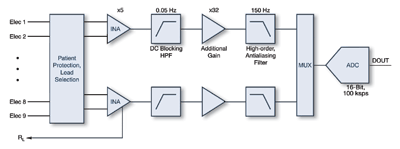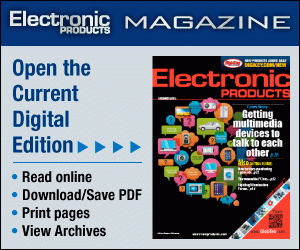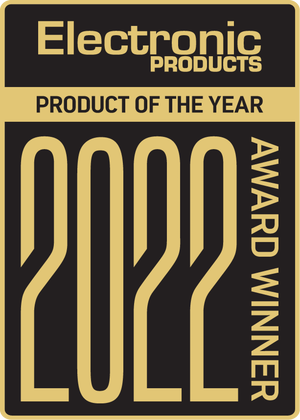Trends in data conversion for medical applications
A highlight on some of the uniquely integrated feature sets for ultrasound and patient-monitoring applications
BY STEVE DEAN
Texas Instruments, Dallas, TX
http://www.ti.com/medical
Traditional A/D converters (ADCs) are giving way to a more specialized set of products often referred to as analog front-ends (AFEs). These devices deliver an improved level of integration providing size, power, and performance optimization, as well as cost savings for the medical system designer. The integration is commonly associated with a purposeful set of functions for a specific medical end equipment or specific medical application.
Electrocardiogram AFEs
The electrocardiogram (ECG) front-end signal chain will be examined as our first example. ECG is a technique that is used to measure the electric potential generated by the heart during a contraction. The electrodes that contact the skin communicate a unique electrical signature based on their position with respect to the heart. Accurately acquiring these electric signals is challenging at the board and system level in the midst of dynamic electrode contact resistance, noise, and motion artifacts from the patient.
There are various approaches to be considered for ECG signal acquisition along with tradeoffs and the effects on your overall system design. The primary components of a traditional discrete ECG AFE include instrumentation amplifiers, operational amplifiers that implement active filters, and ADCs. Using a lower gain of approximately six and a simultaneously sampling high-resolution (16 to 24-bit) ADC is optimum with respect to complexity, accuracy, power, and size.

Fig. 1. Typical discrete ECG analog front-end.
Figure 1 shows that there is a significant amount of analog signal processing that includes multiple gain and filtering stages prior to signal digitization. Considering analog and digital processing options, signal processing in the analog domain limits flexibility, but in any case gain, bandwidth, and dc tracking must be optimized.
Processing in the digital domain provides the benefits of being relatively low in cost and offers a great level of flexibility. Therefore, the system described in the next section follows this digital signal processing approach, leveraging the ADS1298 AFE as an example.
Using an eight-channel 24-bit ADC in this front-end solution reduces component count by providing application-specific integration and power consumption by up to 95%, as compared to discrete implementations. This results in a power efficiency of 1 mW/channel while maintaining highest levels of diagnostic accuracy.
A simplified system design approach can save board space, using up to 95% fewer components by integrating all common features required for application-specific ECG and EEG front ends. These could include eight low-noise PGAs and high-resolution simultaneous-sampling ADCs, integrated amplifiers for right-leg drive and for Wilson center terminal (WCT) and Goldberger terminals (GCT), digital pace detection capability, continuous lead-off detection and an on-chip oscillator and reference for smaller footprint and low-power applications.
Ultra-low-power consumption provides the opportunity for improved battery life or reduced cell size. Coupled with a high level of integration and reduced component count will continue to allow for improved equipment portability and, therefore, patient mobility, patient comfort, and improved patient outcomes.

Fig. 2. This open-source environment shows the analog system design (lADS1298) leveraging the TQFP package that can be built with a simple two- or four-layer board.
More common to embedded system design, a new trend in analog, and specifically ADC development and support, is the beginning of open-source system design forums. Engineers can now find open-source examples of 12-lead ECG systems using software pace detection. Using this technique, pace detection remains versatile and allows customers unrestricted freedom to implement their intellectual property according to their scheme.
Additionally, this open-source environment shows the analog system design (layout in Fig. 2 ) leveraging the TQFP package that can be built with a simple two or four layer board. This relatively new level of sharing on an open-source community in the analog domain will further speed end equipment time to market.
Ultrasound AFEs
Like ECG, ultrasound imaging has been used as a diagnostic tool in medicine for many years. Ultrasound is popular because it’s non-invasive, cost-effective, and portable and it provides real-time results. Unlike CT and x-ray, it carries no risk of radiation exposure.
Improved semiconductor integration allows new frontiers with portable ultrasound systems, bringing diagnosis to triage units and first responders as well as remote locations where access to medical centers is an issue. Recent innovations are making it possible for new ultrasound systems to achieve much lower power and a significantly smaller footprint by integrating application-specific functions, enabling the ultrasound system to move from the clinic to the field, and even into a doctor’s pocket.
Typical ultrasound receive signal chains include low-noise amplifiers (LNAs), voltage-controlled attenuators (VCAs), and programmable gain amplifiers (PGAs), as well as low pass filtering and discrete ADCs.
The LNA provides low-noise amplification for good sensitivity. LNA noise performance is critical as it generally determines the noise performance of the entire receiver. The VCAs’ function is to provide sufficient dynamic range over the full receive cycle. VCAs allow the gain to be increased with time to compensate for the increased attenuation of the signal as it passes through the body. The antialias low-pass filters assist in improving the signal-to-noise ratio (SNR).
The ADCs typically feature 12- or 14-bit resolution running from 40 to 65 Msamples, while offering good instantaneous SNR. Key requirements for an ADC in an ultrasound system include low power for portability and higher channel count in systems, high sampling frequency to support high-frequency probes, good channel-to-channel matching for accurate images, fast overload recovery to prevent any information loss, and high integration such as serial outputs for easy connection to the processor.
Integrating complex and critical functions in a single analog front-end results in significant board space savings and, therefore, simpler designs, which increases system reliability. Figure 3 shows a rendition of the ultrasound receive signal chain in its integrated form.

Fig. 3. Ultrasound receive signal chain.
The graphic shows what can be expected in a highly integrated analog front-end (AFE) solution such as the AFE58xx family specifically designed for ultrasound systems in which high performance and small size are required. New solutions include CW mixers, several resolution options as well as multiple power dissipation and noise performance options for a wide range of system solutions targeted for different ultrasound and platform needs.
Most AFEs will also feature LVDS data outputs. Further integration activity in the next two years could find features such as integrated system clock functions, additional ADCs for the spectral Doppler processing function, and an increased number of channels on the receive side.
Tool kits speed time to market
Common trends in medical ASICs include application specific and near-system-level evaluation modules (EVMs) and took kits. Examples in ECG and ultrasound are now common. Hardware reference designs, layout/Gerber files, as well as open-source algorithms will be available.
Expect these trends in feature-rich EVMs and tool kits to expand into other medical end equipment sets such as automated external defibrillators, and clinical instruments. These advancements are improving the accessibility and quality of healthcare in the U.S. and around the world. ■
Advertisement
Learn more about Texas Instruments





